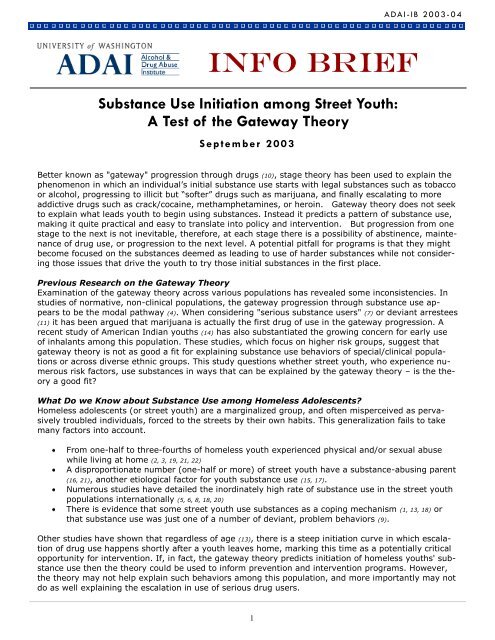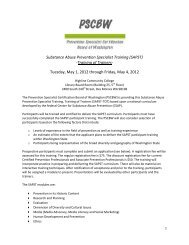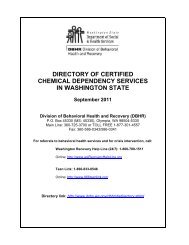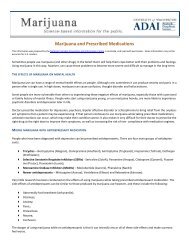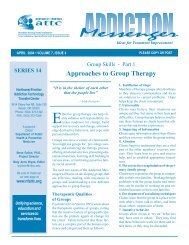Substance Use Initiation by Street Youth - Alcohol and Drug Abuse ...
Substance Use Initiation by Street Youth - Alcohol and Drug Abuse ...
Substance Use Initiation by Street Youth - Alcohol and Drug Abuse ...
Create successful ePaper yourself
Turn your PDF publications into a flip-book with our unique Google optimized e-Paper software.
ADAI-IB 2003-04INFO Brief<strong>Substance</strong> <strong>Use</strong> <strong>Initiation</strong> among <strong>Street</strong> <strong>Youth</strong>:A Test of the Gateway TheoryS eptem ber 2003Better known as "gateway" progression through drugs (10), stage theory has been used to explain thephenomenon in which an individual‟s initial substance use starts with legal substances such as tobaccoor alcohol, progressing to illicit but “softer” drugs such as marijuana, <strong>and</strong> finally escalating to moreaddictive drugs such as crack/cocaine, methamphetamines, or heroin. Gateway theory does not seekto explain what leads youth to begin using substances. Instead it predicts a pattern of substance use,making it quite practical <strong>and</strong> easy to translate into policy <strong>and</strong> intervention. But progression from onestage to the next is not inevitable, therefore, at each stage there is a possibility of abstinence, maintenanceof drug use, or progression to the next level. A potential pitfall for programs is that they mightbecome focused on the substances deemed as leading to use of harder substances while not consideringthose issues that drive the youth to try those initial substances in the first place.Previous Research on the Gateway TheoryExamination of the gateway theory across various populations has revealed some inconsistencies. Instudies of normative, non-clinical populations, the gateway progression through substance use appearsto be the modal pathway (4). When considering "serious substance users" (7) or deviant arrestees(11) it has been argued that marijuana is actually the first drug of use in the gateway progression. Arecent study of American Indian youths (14) has also substantiated the growing concern for early useof inhalants among this population. These studies, which focus on higher risk groups, suggest thatgateway theory is not as good a fit for explaining substance use behaviors of special/clinical populationsor across diverse ethnic groups. This study questions whether street youth, who experience numerousrisk factors, use substances in ways that can be explained <strong>by</strong> the gateway theory – is the theorya good fit?What Do we Know about <strong>Substance</strong> <strong>Use</strong> among Homeless Adolescents?Homeless adolescents (or street youth) are a marginalized group, <strong>and</strong> often misperceived as pervasivelytroubled individuals, forced to the streets <strong>by</strong> their own habits. This generalization fails to takemany factors into account.From one-half to three-fourths of homeless youth experienced physical <strong>and</strong>/or sexual abusewhile living at home (2, 3, 19, 21, 22)A disproportionate number (one-half or more) of street youth have a substance-abusing parent(16, 21), another etiological factor for youth substance use (15, 17).Numerous studies have detailed the inordinately high rate of substance use in the street youthpopulations internationally (5, 6, 8, 18, 20)There is evidence that some street youth use substances as a coping mechanism (1, 13, 18) orthat substance use was just one of a number of deviant, problem behaviors (9).Other studies have shown that regardless of age (13), there is a steep initiation curve in which escalationof drug use happens shortly after a youth leaves home, marking this time as a potentially criticalopportunity for intervention. If, in fact, the gateway theory predicts initiation of homeless youths' substanceuse then the theory could be used to inform prevention <strong>and</strong> intervention programs. However,the theory may not help explain such behaviors among this population, <strong>and</strong> more importantly may notdo as well explaining the escalation in use of serious drug users.1
Study Conducted Among Seattle <strong>Street</strong> <strong>Youth</strong>Our study looked at 375 homeless adolescents between the ages of 13 to 21 (M = 17.14 yr.), who wereparticipating in a larger study of street youth in Seattle, <strong>and</strong> interviewed between 1994 <strong>and</strong> 1999 (2). Participantswere recruited <strong>by</strong> interviewers who intercepted the youth at strategic street locations or at oneof seven youth service agencies. The majority of participants identified themselves as Caucasian(52.5%), followed <strong>by</strong> American Indian or Alaskan native (18.9%), Black (17.6%), Hispanic/Latino(7.2%), <strong>and</strong> Asian/Pacific Isl<strong>and</strong>er (2.7%). Slightly more than 45% were female.<strong>Alcohol</strong> use was assessed <strong>by</strong> asking participants if they had ever tried any alcohol, <strong>and</strong> if so, at what age.Participants were also asked about the frequency of alcohol use in the past year. In this study, both categoriesof alcohol use were considered together, <strong>and</strong> the age of first use was taken as the earliest for thetwo types of alcohol if the participant had tried both.Marijuana <strong>and</strong> other drug use were assessed <strong>by</strong> questions about their lifetime use of marijuana <strong>and</strong> of 12other categories of drugs. If youth reported using a drug, they were asked their age at first use, <strong>and</strong>their frequency of use in the past 6 months.Data AnalysisThe sequence of substance use was analyzed <strong>by</strong> determining the particular pattern of progression foreach individual, with drugs classified into the categories of alcohol, marijuana, <strong>and</strong> other drugs --- a similarclassification to that used <strong>by</strong> Mackesy-Amiti (12). The "other" category of drugs included cocaine, LSD,psychoactive mushrooms, ecstasy, crank, heroin or other opiates, speed, crystal methamphetamines,tranquilizers, Quaaludes, inhalants, or abused over the counter drugs.Participants who had not tried all three categories of drugs defined in our gateway sequences (alcohol,marijuana, <strong>and</strong> other drugs) were classified as „nonprogressors,‟ <strong>and</strong> those who had tried all three wereclassified as „progressors.‟ In sequencing the progressors in the sample, it was necessary to determinewhat to do with „ties;‟ that is, participants' reporting of having tried more than one category of substancesat the same age. We alternated assignment of the possible sequences in the event of ties. For example,if two subjects reported that they initiated use of both alcohol <strong>and</strong> marijuana at age eleven, <strong>and</strong>tried cocaine first at the age of thirteen, one subject would be classified in the alcohol, marijuana, thenother sequence, <strong>and</strong> the other would be grouped as using marijuana, alcohol, then other drugs. In theevent that all drugs were reportedly initiated at the same age, we alternated among the six possiblecombinations of sequences. Thirty-six youth (9.6%) initiated their substance use with alcohol <strong>and</strong> marijuanawithin the same time frame (i.e., two-way ties), <strong>and</strong> 30 youth (8%) initiated their substance usewith all three categories of substances within the same time frame (i.e., three-way ties).Subsequently, we analyzed the likelihood that participants who tried one class of drug would then initiateuse of other drugs along the hypothesized gateway progression. The next set of analyses examinedwhether current use of substances was related to the order of initiation of the gateway drugs. We alsotested the effects that age, "age that youth first left home," "age that youth first used any substance(except tobacco)," <strong>and</strong> "number of times the youth has left home," have on the sequence of substanceinitiation to determine whether there were any differences in age among the different progressions patterns.ResultsThe data reveal that while a significant proportion of the street youth interviewed followed the gatewayprogression of substance initiation, this progression is not prevalent enough to consistently predict theorder of initiation among a majority of street youth. One-third of the youth tried alcohol first, marijuanasecond, <strong>and</strong> a „harder‟ drug third. However, 44% of the youth initiated these three classes of substancesin a different order <strong>and</strong> 22% have not even initiated all three classes of substances. Thus, our samplehas among the lowest rates of individuals following the gateway progression when compared to normativepopulations, although the one-third rate has been found in non-normative or deviant populations (7,12)2
Sequence Frequency PercentCummulativePercentHave not used all 3 categories (nonprogressors) 84 22.4 22.4<strong>Alcohol</strong>, Marijuana, Other (AMO) 125 33.3 55.7<strong>Alcohol</strong>, Other, Marijuana (AOM) 60 16.0 71.7Marijuana, <strong>Alcohol</strong>, Other (MAO) 49 13.1 84.8Marijuana, Other, <strong>Alcohol</strong> (MOA) 24 6.4 91.2Other, <strong>Alcohol</strong>, Marijuana (OAM) 19 5.1 96.3Other, Marijuana, <strong>Alcohol</strong> (OMA) 14 3.7 100.0Total 375 100.0 100.0<strong>Drug</strong> <strong>Use</strong> <strong>Initiation</strong> Sequences for Homeless Adolescent Sample (N = 375)In general, these data were able to shed light on several pertinent issues in the substance abuse literature.Gateway theory did not increase our underst<strong>and</strong>ing of substance use initiation for street youth,leaving the behaviors of many in our sample unaccounted for. To illustrate, for street youth who startusing substances at a younger age, there is a greater likelihood of progressing in a typical gatewayfashion, starting with alcohol <strong>and</strong> moving through marijuana to harder drugs. Moreover, this findingconcurs with that of Mackesy-Amiti et al. (9). However, these individuals are no more likely to be usingsubstances currently than youth who tried all three categories of drugs in a different sequence. For aneven larger proportion of the participants, there is an atypical progression to serious drug use. This mayindicate that a view of alcohol or marijuana as necessary steps in the progression to substance abuseproblems is shortsighted. Alternatively, it may be that early initiators, particularly those who begin usingheavily before leaving home, do not have many options other than the most common substancessuch as alcohol <strong>and</strong> marijuana. Subsequently, when the late initiators begin using, their cohort has awider exposure to a greater number of drugs via association with the early initiators, who have alreadymoved on to other illicit substances. Late initiators, therefore, are less likely to start with the most commonsubstances, or they move to more serious substance use rapidly.With the current sample of street youth this could very well be the case, in that there is a high rate ofsubstance use, particularly experimentation with drugs such as methamphetamine <strong>and</strong> heroin that areconsidered to represent a high level of risk. The general public <strong>and</strong> professionals consider these drugsto be an endpoint drug, in that people progress toward these drugs as their substance use moves in amore extreme direction. Unfortunately, experimentation with methamphetamine <strong>and</strong> heroin, for example,often leads to more involved use because of the addictive nature of these drugs. Thus, regardlessof whether youths get a running start <strong>by</strong> more heavily using more common substances of use such asalcohol or marijuana, once they begin using highly addictive drugs (e.g., cocaine, amphetamines, heroin,etc.) their use patterns are more likely to become heavier <strong>and</strong> riskier (e.g., intravenous route of administration).<strong>Street</strong> youth, unlike many other samples of youth examined with regard to their sequentialprogression of substance initiation, are less likely to fit a typical gateway pattern, <strong>and</strong> more importantly,their current use is not as likely to relate to the substances they previously tried.CommentsIdentifying gateway drugs also ignores the changing face of the drug scene. Currently, there is growingconcern over the use of crystal methamphetamines <strong>and</strong> ecstasy, but historical trends would suggestthat in the next decade the youth who are coming into serious drug use will find another substance beingbrought to them <strong>by</strong> the drug using pioneers. Certainly alcohol <strong>and</strong> marijuana were the substancesmost used, so programmatically it seems rational to keep the intervention focus on these substances.However, we need to be aware that the chaos present in the lives of homeless youth may be mirroredin the choices they make about using substances. Interventionists might capture a broader slice of thispopulation if programs are not substance specific, but rather focus on the risks faced <strong>by</strong> street youth forgeneral substance use initiation, as well as progression <strong>and</strong> maintenance of use.3
References1. Adlaf E. M., Zdanowicz Y. M., Smart R. G. (1996) <strong>Alcohol</strong> <strong>and</strong> other drug use among street-involved youths in Toronto, AddictionResearch, 4 (1) 11–24.2. Cauce A. M., Paradise M., Ginzler J. A., Embry L., Morgan C., Lohr Y., Wagner V. (2000) The characteristics <strong>and</strong> mental healthof homeless adolescents: age <strong>and</strong> gender differences, The Journal of Emotional <strong>and</strong> Behavioral Disorders, 8 (4) 230–239.3. Dembo R. M., Williams L., Berry E., Getreu A. ) (1989b) The relationship between physical <strong>and</strong> sexual abuse <strong>and</strong> illicit druguse: A replication among a new sample of youths entering a juvenile detention center, International Journal of the Addictions, 23(11 1101–1123.4. Fergusson D. M., Horwood L. J. (2000) Does cannabis use encourage other forms of illicit drug use?, Addiction, 95 505–520.5. Fors S. W., Rojek D. G., (1991) A comparison of drug involvement between runaways <strong>and</strong> school youths, Journal of <strong>Drug</strong> Education,21 (1) 13–25.6. Forst M. L. (1994) A substance-use profile of delinquent <strong>and</strong> homeless youths, The International Journal of Psychiatry in Medicine,24 (3) 219–231.7. Golub A., Johnson B (1994b) The shifting importance of alcohol <strong>and</strong> marijuana as gateway substances among serious drug abusers,Journal of Studies on <strong>Alcohol</strong>, 55 607–614.8. Greene J. M., Ennett S. T. (1997) <strong>Substance</strong> use among runaway <strong>and</strong> homeless youth in three national samples, American Journalof Public Health, 87 (2) 229–235.9. Jessor R., Jessor S. L. (1977) Problem behavior <strong>and</strong> psychosocial development: A longitudinal study of youth, Academic Press,New York, p. 281.10. K<strong>and</strong>el D. B., Kessler R. C., Margulies R. Z., (1978) Antecedents of adolescent initiation into stages of drug use: A developmentalanalysis, Journal of <strong>Youth</strong> <strong>and</strong> Adolescence, 7 (1) 13–40.11. Kane R. J., Yacoubian G. S. Jr. (1999) Patterns of drug escalation among Philadelphia arrestees: An assessment of the gatewaytheory, Journal of <strong>Drug</strong> Issues, 29 (1) 107–120.12. Mackesy-Amiti M. E., Fendrich M., Goldstein P. J. (1997) Sequence of drug use among serious drug users: typical vs. atypicalprogression, <strong>Drug</strong> <strong>and</strong> <strong>Alcohol</strong> Dependence, 45 185–196.13. MacLean M. G., Paradise M. J., Cauce A. M. (1999) <strong>Substance</strong> use <strong>and</strong> psychological adjustment in homeless adolescents: Atest of three models, American Journal of Community Psychology, 27 (3) 405–427.14. Novins D. K., Plunkett M., Beals J. (1998) Stages of drug use among American Indian adolescents, Problems of <strong>Drug</strong> Dependence1997, Proceedings of the 59th Annual Scientific Meeting, p. 249. NIDA Monograph Series #178.15. Oetting E. R., Donnermeyer J. F. (1998) Primary socialization theory: The etiology of drug use <strong>and</strong> deviance. Part 1, <strong>Substance</strong><strong>Use</strong> & Misuse, 33 995–1026.16. Robertson M. J., Koegel P., Ferguson L (1990) <strong>Alcohol</strong> use <strong>and</strong> abuse among homeless adolescents in Hollywood, British Journalof Addiction, 86 999–1010.17. Sher K. J. (1997) Psychological characteristics of children of alcoholics, <strong>Alcohol</strong> Health <strong>and</strong> Research World, 21 (3) 247–254.18. Smart R. G., Adlaf E. M. (2001) <strong>Substance</strong> use <strong>and</strong> problems among Toronto street youth. British Journal of Addiction, 86 (8)999–1010.19. Tyler K. A., Hoyt D. R., Whitbeck L. B., Cauce A. M. (2001) The impact of childhood sexual abuse on later sexual victimizationamong runaway youth, Journal of Research in Adolescence, 11 (2) 151–176.20. Unger J. B., Kipke M. D., Simon T. R., Montgomery S. B., Johnson C. J. (1997) Homeless youths <strong>and</strong> young adults in Los Angeles:prevalence of mental health problems <strong>and</strong> the relationship between mental health <strong>and</strong> substance abuse disorders, AmericanJournal of Community Psychology, 25 (3) , 371–394.21. Whitbeck L. B., Hoyt D. R. (1999) Nowhere to grow: Homeless <strong>and</strong> runaway adolescents <strong>and</strong> their families. New York: AldineDe Gruyter, p. 216.22. Whitbeck L. B., Hoyt D. R., Ackley K. A. (1997) Families of homeless <strong>and</strong> runaway adolescents: A comparison of parent/caretaker <strong>and</strong> adolescent perspectives on parenting, family violence <strong>and</strong> adolescent conduct, Child <strong>Abuse</strong> <strong>and</strong> Neglect, 21 (6) 517–528.Source:Ginzler JA, Cochran BN, Domenech-Rodriguez M, Cauce AM, Whitbeck LB. Sequential Progression of <strong>Substance</strong> <strong>Use</strong>among Homeless <strong>Youth</strong>: An Empirical Investigation of the Gateway Theory. <strong>Substance</strong> <strong>Use</strong> & Misuse 38(3-6):725-758, 2003.Info Brief Citation: <strong>Substance</strong> <strong>Use</strong> <strong>Initiation</strong> among <strong>Street</strong> <strong>Youth</strong>: A Test of the Gateway Theory. (ADAI InfoBrief). Prepared <strong>by</strong> Meg Brunner, MLIS for the UW <strong>Alcohol</strong> & <strong>Drug</strong> <strong>Abuse</strong> Institute, September 2003.URL: http://adai.uw.edu/pubs/infobriefs/ADAI-IB-2003-04.pdfFind more information in the ADAI Library <strong>and</strong> the ADAI Clearinghouse.4


